The Real Woodstock ’69: It Wasn’t About the Music

I went to Woodstock. The original one, in 1969. When I tell younger friends about it, it’s as if I’d claimed to have been present at the reading of the Gettysburg Address. It’s ancient history, 50 years ago. And that’s why we’re celebrating it this month, with not only news specials and TV documentaries (including Woodstock at 50, August 17 on CNN; PBS' recent Woodstock: Three Days That Defined a Generation, and many more) but a 38-CD (you read that right) collection called Woodstock: Back to the Garden/The Definitive 50th Anniversary Archive (Rhino). The latter (released August 2) is packaged in “a screen-printed plywood box with canvas insert inspired by the Woodstock stage set.” The 38th CD in the set is just crowd noise and stage announcements.
I won’t be buying it. And I won’t be watching The Director’s Cut of Mike Wadleigh’s original documentary or reading the new coffee table book that breathlessly runs down the acts on stage, band by band. Remember Quill? They came, they played.
You can’t package Woodstock into a nice bar-coded package. It wasn’t a marketing phenomenon; it was an authentic happening, which is why attempts to repackage its magic (even by the original promoter, Michael Lang), have mostly failed. I was at Woodstock ’94, too, and it was a debacle, with lousy music, rip-off food prices and zero tribal spirit. Woodstock 50? It has already canceled, and I would have given it a miss in any case. My lack of interest in seeing the ‘60s warhorses is equaled by a similar antipathy to many of the acts that were booked for the reunion. Miley Cyrus? Really?
Lang and partner Artie Kornfeld didn’t plan on making history. They planned a ticketed three-day rock festival, one of many that were happening around that time. I read about it in Rolling Stone. Yes, it was “peace and music,” but despite the war raging at that time, I don’t remember activism being a big part of it.
I was 17, newly licensed. My brother John and I drove up to Monticello in our beat-up 1962 Nova convertible. We went early, didn’t encounter much traffic, and parked in a muddy field right next to the infamous skinny-dipping pond. Later, after the rains and the car sinking up to its axles in the mud, we had to be towed out by a farmer’s tractor.
Now here’s the thing. Everyone asks me about the music, but it’s not what I remember best. Sure, I heard Janis Joplin (the only time I heard her, actually), saw Jimi Hendrix play the “Star-Spangled Banner” and Grace Slick of the Jefferson Airplane proclaim, “You’ve heard the heavy groups, now here’s morning maniac music.” I remember the “bad acid” stage announcements.
But for the most part, I wasn’t staring at the stage in awe. I was wandering the site, reveling in was later dubbed Woodstock Nation. “A lot of freaks,” Arlo Guthrie proclaimed. (“Hippies” preferred being called “freaks.” It’s a cultural thing no one remembers.)
That weekend we were the third biggest city in New York State. We felt proud to have virtually shut down the New York State Thruway. There were 300,000 to 400,000 freaks in one place, the biggest sign yet that the Age of Aquarius was going to take over the world and stuff flowers into the gun barrels. Before that, we felt isolated in our little pockets of dissent, unsure of our numbers. (This was decades before digital technology, the internet, smart phones and social media.)
At Woodstock, everyone walked around amazed at all the long hair (which still meant something then). Everybody was nice to everybody else. Food was shared, as were sleeping bags. Nobody got murdered. Precious few were ripped off. It was a short-lived dream, this idea that harmony could reign, shattered only a few months later at the Rolling Stones’ Altamont Speedway “free concert” in California (where a man named Meredith Hunter actually was murdered).
Even though she wasn’t actually there, Joni Mitchell wrote “Woodstock” (the song) and it resonated, with its words about “getting back to the garden.” Had we created Eden, maybe a modern Camelot? Sure, I’ll go with that.
But no amount of marketing magic is going to recreate it. Woodstock became a free festival not because we were hippies and money didn’t matter, but because they couldn’t contain the crowds. It became a resonant symbol of all that was good in the counterculture despite its base in the (then despised) hippie capitalism.
Stuff like this happens but it’s never planned, and it can’t be hatched with charts and graphs in a corporate boardroom. Let’s wave goodbye to Woodstock Nation for a minute and look at a more contemporary example. I’ve been a blogger for CarTalk.com since 2008. The show, featuring Click and Clack, the Tappet Brothers (Tom and Ray Magliozzi), didn’t emerge from demographic studies, and it wasn’t planned in advance.
Tom Magliozzi appeared as a guest circa 1977 on a WBUR program in Boston, his hometown. People called in; they thought he was funny. He appeared again, this time with his equally funny younger brother, Ray. They got their own WBUR car talk show, and it was insanely popular, so it went viral on the NPR network in 1986.
My point is that the idea of a car-based talk show featuring brothers with strong Boston accents would never have been greenlighted by MBAs. It had to be on the air and tested in front of audiences before the marketing team could see its potential.
But even then, when the brothers could have signed marketing and endorsement deals left and right, they mostly didn’t. It wasn’t them. It wasn’t Car Talk. They made the right decision. Bob Vila fell from grace at This Old House on PBS simply because he went too far down the endorsement rat hole.
After the death in 2014 of Tom Magliozzi (who just posthumously received a plaque in Harvard Square), the show could have gone on with new hosts, other funny people who talked about cars. But all concerned seem to acknowledge that it was a unique confluence, unlikely to be recreated.
So I didn’t watch Woodstock; I lived it for three glorious days. I still have the photos I took there and printed in my darkroom in a box somewhere. Unpublished! Should I cash in and sell them in an exclusive portfolio of 1969 editions, printed on acid-free paper made from the muddy sleeping bags, with un-torn Woodstock tickets a special incentive for the deluxe version? Nah. I’m going to let that one lie. Anyway, I lost those tickets in a move many years ago.
Photo at top provided by Jim Motavalli. Taken at Woodstock ’69. Is it Jim or brother John?
Click on the social media tiles above or below to share this content with your friends and colleagues.
The opinions and points of view expressed in this commentary are exclusively those of the author and/or subject(s) and do not necessarily represent the views of MediaVillage.com/MyersBizNet, Inc. management or associated bloggers.


